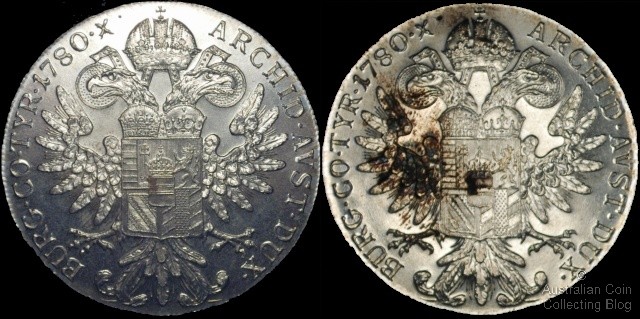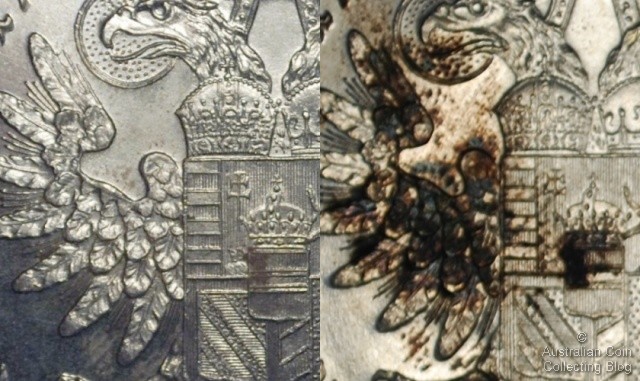Sometimes, no matter how careful you are you'll find that your coins will develop toning or carbon spots while they are in your albums. If you're a regular reader of this blog you'll know exactly how careful the authors of this blog are storing our collections, we make use of archival grade coin albums, PVC free coin album pages, and the excellent PET SAFLIP coin holders. Despite all of this I was interested to find a coin in my collection that had toned considerably since it was purchased about 2 years ago. You can see the reverse of the coin below, the image on the left was taken when it was purchased and the one on the right just yesterday. You can certainly see the difference!

Austria 1780 Taler Restrike - Coin in 2008 on Left, coin in 2010 on right
Closer examination of the large (and pretty ugly) toning spot on the coin indicated that it was a fingerprint. If you don't know it your fingers are covered in skin oils and these can certainly adhere to the surface of a coin and over time will etch and tone the surface of a coin and clearly this is what happened here. When I receive coins for my own collection I only handle them wearing cotton gloves so I was fairly certain that I hadn't left a big greasy fingerprint on this coin, so I took a closer look at the image of the coin from a couple of years ago. You can see the detailed comparison of the coin two years apart below.

Austria 1780 Taler Restrike - Coin in 2008 on Left, coin in 2010 on right
You can see that in 2008 the coin had faint toning in the centre of the coat of arms and traces of a fingerprint in the fields above the eagles wing. So obviously the fingerprint was there when I received the coin. It's also apparent that the coin had most likely been dipped at some time as the lustre was flat and a little un-natural. This wouldn't have concerned me as I buy these taler restrikes partly out of interest and partly because they are a fun (and attractive) way to hold silver bullion. So perhaps this past dip was designed to remove an old fingerprint? Well whatever the case, it didn't work as the toning in the centre of the coat of arms has darkened and spread and the fingerprint has bloomed horribly. So what are the lessons that can be learned from this?
- Handle all your coins when they are out of their holders wearing clean cotton gloves. At least then you can be assured that any fingerprints on a coin are not yours!
- Make sure you take a look at your collection regularly to keep an eye on the condition of your coins. If a coin is toning keep an eye on it, if red copper is going brown consider re-holdering it, and if coins are developing verdigris isolate those coins and treat them immediately.
- Take images of your coins when you buy them, you'll be able to refer back and see if they are changing.
- Consider giving all your new coins a quick rinse in acetone before storing them. This will not effect the surface of the coins but it will remove any residual oils and organic material from the surface of the coin.
- Use proper storage materials, remove PVC from your collection and use archival grade storage accessories. At least then you can be happy that any toning or change in the condition of your coins was a process that started before you obtained your coins. Remember that toning is often an active and on-going process and may have started before you got a coin and will often continue once you have it in your collection regardless of how you store your coins.
So what could I have done to stop my 1780 taler restrike from toning like it has? Well I could have given it a quick bath in acetone when I got it in 2008 (and I may well have done but I don't remember). Given that I can see some toning on the 2008 image of the coin the process had probably started already. Acetone may have removed other oils on the coin and prevented the extent of the toning but I am sure the toning would have darkened anyway. From a storage point of view there's not a lot more I could have done, the coin has been stored in a SAFLIP, in a PVC free coin album page which was stored in an archival grade polypropylene coin album.
I'll make a mental note to bring this coin out again in a year or so and take a look and see if the toning continues to progress. The coin hasn't been treated in any way so it should be interesting to see what it looks like in a year!
Posted by mnemtsas at March 22, 2010 11:01 AM
Subscribe to our Newsletter


